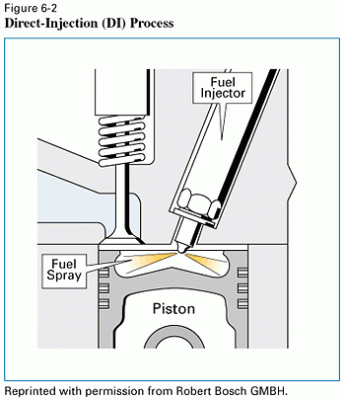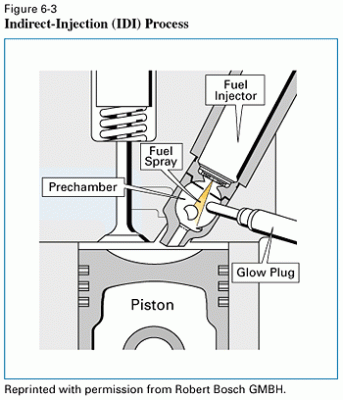dbarilow
over worked
IDI info from Chevron
http://www.chevron.com/products/prodserv/fuels/bulletin/diesel/L2_6_3_rf.htm
DIRECT-INJECTION AND INDIRECT-INJECTION
The two fuel injection processes used in diesel engines, direct-injection (DI) and indirect-injection (IDI), are illustrated in Figures 6-2 and 6-3 (see below). In a DI engine, fuel is injected directly into the cylinder above the piston. In an IDI engine, fuel is injected into a small prechamber connected to the cylinder via a narrow passage that enters the prechamber tangentially. During the compression process, air is forced through this passage, generating a vigorous swirling motion in the prechamber. Then fuel is injected into the prechamber and ignition occurs there. The combination of rapidly swirling air in the prechamber and the jet-like expansion of combustion gases from the prechamber into the cylinder enhances the mixing and combustion of the fuel and air.
Figure 6-2
Figure 6-3
back to top
The more rapid mixing of fuel and air achieved in IDI engines comes at a price, however. The high velocity flow of air through the narrow passage connecting the main cylinder to the prechamber, as well as the vigorous swirling motion in the prechamber itself, causes the air to lose significantly more heat during compression than it does in a DI engine. Coupled with a pressure drop from the main chamber to the prechamber, this results in an air temperature in the prechamber after compression that is lower than that in a similar DI engine.
Since rapid fuel autoignition requires a certain air temperature, an IDI engine needs a higher compression ratio to achieve the desired air temperature in the prechamber. IDI engines operate at compression ratios of about 20:1 to 24:1; while DI engines operate at ratios of about 15:1 to 18:1. The heat losses that necessitate these higher compression ratios have another, more important effect: they decrease the efficiency of the engine. IDI engines typically achieve fuel efficiencies that are 10% to 20% lower, on a relative basis, than comparable DI engines.
Even with the higher compression ratios, IDI engines may still be hard to start. Most IDI engines use glow plugs to heat the air in the prechamber in order to make starting easier. Glow plugs, which are small resistive heaters, are usually powered for only the first few minutes of engine operation.
With the negative attributes of harder starting and lower efficiency, one may wonder why IDI diesel engines are used at all. The answer is engine speed. As an engine gets smaller, generally it must operate at higher speeds to generate the desired power. As engine speed increases, there is less time per engine cycle to inject, vaporize, mix, and combust the fuel. As a result, the higher mixing rates afforded by IDI designs become necessary to achieve good combustion at higher engine speeds. IDI diesels most commonly are used in smaller automotive and light duty truck applications.
http://www.chevron.com/products/prodserv/fuels/bulletin/diesel/L2_6_3_rf.htm
DIRECT-INJECTION AND INDIRECT-INJECTION
The two fuel injection processes used in diesel engines, direct-injection (DI) and indirect-injection (IDI), are illustrated in Figures 6-2 and 6-3 (see below). In a DI engine, fuel is injected directly into the cylinder above the piston. In an IDI engine, fuel is injected into a small prechamber connected to the cylinder via a narrow passage that enters the prechamber tangentially. During the compression process, air is forced through this passage, generating a vigorous swirling motion in the prechamber. Then fuel is injected into the prechamber and ignition occurs there. The combination of rapidly swirling air in the prechamber and the jet-like expansion of combustion gases from the prechamber into the cylinder enhances the mixing and combustion of the fuel and air.
Figure 6-2
Figure 6-3
back to top
The more rapid mixing of fuel and air achieved in IDI engines comes at a price, however. The high velocity flow of air through the narrow passage connecting the main cylinder to the prechamber, as well as the vigorous swirling motion in the prechamber itself, causes the air to lose significantly more heat during compression than it does in a DI engine. Coupled with a pressure drop from the main chamber to the prechamber, this results in an air temperature in the prechamber after compression that is lower than that in a similar DI engine.
Since rapid fuel autoignition requires a certain air temperature, an IDI engine needs a higher compression ratio to achieve the desired air temperature in the prechamber. IDI engines operate at compression ratios of about 20:1 to 24:1; while DI engines operate at ratios of about 15:1 to 18:1. The heat losses that necessitate these higher compression ratios have another, more important effect: they decrease the efficiency of the engine. IDI engines typically achieve fuel efficiencies that are 10% to 20% lower, on a relative basis, than comparable DI engines.
Even with the higher compression ratios, IDI engines may still be hard to start. Most IDI engines use glow plugs to heat the air in the prechamber in order to make starting easier. Glow plugs, which are small resistive heaters, are usually powered for only the first few minutes of engine operation.
With the negative attributes of harder starting and lower efficiency, one may wonder why IDI diesel engines are used at all. The answer is engine speed. As an engine gets smaller, generally it must operate at higher speeds to generate the desired power. As engine speed increases, there is less time per engine cycle to inject, vaporize, mix, and combust the fuel. As a result, the higher mixing rates afforded by IDI designs become necessary to achieve good combustion at higher engine speeds. IDI diesels most commonly are used in smaller automotive and light duty truck applications.


